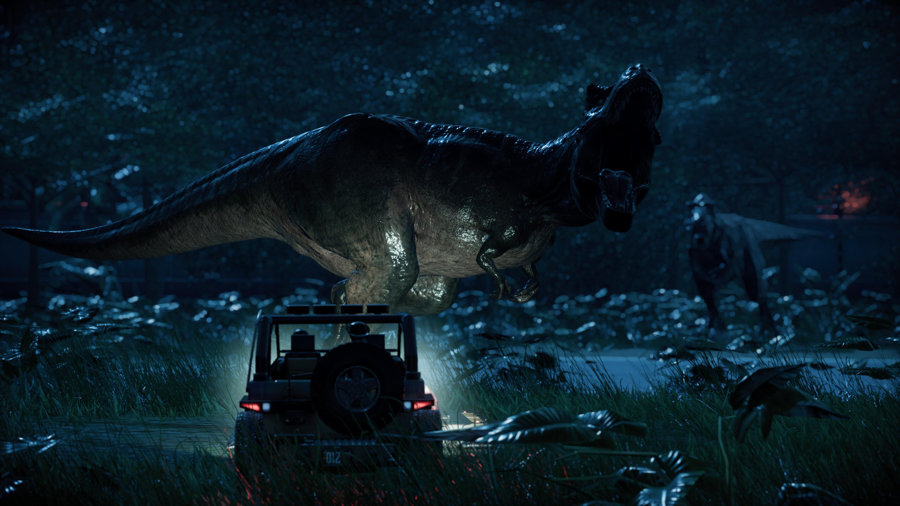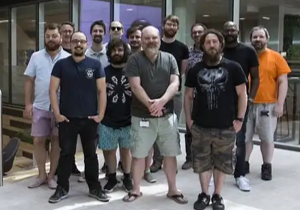


![]() Jurassic World Evolution - Audio Highlights
Jurassic World Evolution - Audio Highlights
A challenge that returns on every project is to understand the right "feel" for audio. A process that is akin to finding the right language for communicating player feedback. When working on an IP - with a well-known sonic and historic identity such as Jurassic Park - this extends to audio, music and v.o. Naturally we embraced this as a pillar for game audio but part of the established "language" also touches on translating intend of the IP holder and audience nostalgia for the sounds they remember the most. All of that happens before we can begin to think about player relevant feedback, memory budgets, technical limitations and mixing.
It is all of equally importance but doesn't always align with the expectations of modern game audio. For example, when the game - for wanting to avoid fatigue - requires variations, nostalgia might lean towards familiar and repetitive sounds.
For the audio team this was a blast of a puzzle to solve: Figuring out what to add, leave alone and update. Senior audio designer Duncan MacKinnon and I spend the first three months on Jurassic World Evolution trying to answer those questions. We experimented with substitution, re-creation, layering and morphing to find a combinations that could add behaviours not seen in the films, yet sounding like a natural extension of the existing sonic signature. When at first we added layers of new recordings to achieve this, we ended up dropping most as it was detracting from the nostalgia requirement when trying to update too much. Instead we ended up relying on techniques that take the original sound as a starting point for adding sweeteners, fx, mastering and creative mixing techniques, such as morphing.
As production on Jurassic World Evolution began to take shape so did the audio direction. To me the goal of that is to create a framework or "story" that the team can fall back on to make decisions. Examples of this are Ui direction or mixing priorities.
For the purpose of building a cohesive audio soundscape, we needed an answer that could anchor to the flow of gameplay and for that it might be good to explain how the game-loop works on our games.
In strategy and management games that Frontier Developments builds, the game context switches between observing, managing feedback and building accordingly. Sometimes that happens while interacting with the diegetic game-world and sometimes using non-diegetic full screen menu overlays.
To define the camera, I took guidance from the full screen overlays as Ui ties most of the gameplay flow together anyway. Unlike the camera the diegetic crowds, dinosaurs and weather can't be directly controlled, but it can be read as if it is a "living" diegetic Ui.

Depending on how much space a menu occupies on screen (from subtle side-bar, to full screen overlay) more "room reverb" is added to Ui sounds. This is most pronounced when transitioning from diegetic visuals with small menu interfaces, to full screen overlays.
When it rains a muffled layer is heard when browsing those full screen menus and thus the storm is also present where the "command room" is. Even if it isn't accessible to the player in the diegetic world, audio and ui screens link the experiences together.


The team ran with it, Pablo Cañas Llorente, Janesta Boudreau and James Stant manged to license a surprisingly large and varied playlist. From those efforts a radio station was created and Pablo and James wrote and recorded a Spanish speaking DJ, broadcasting from the far away shore of Costa Rica. This is another example of using "location" to inform audio direction. To emphasise the distance of the islands from the continent and make the broadcast physically feel real, I used game parameters related to storms to filter the radio music. Before a storm hits the island, the radio begins to crackle and break up and as the storm fully engulfs, there's only static left. The storm is part of a larger world in which the radio signal needs to travel through the ether.
In part because of our diegetic informed direction for audio, our work helps underpin the setting and add to world-building in Jurassic World Evolution.


| [GENRE] | CMS Content Management Simulation |
| [DURATION] | 2016-2017 |
| [ROLE] | Principal Audio Designer / Project Audio Lead |
| [DEVELOPER] | Frontier Developments |
| [PLATFORM] | PC, Xbox, Playstation, Switch |
![]() Audio Team:
Audio Team:




